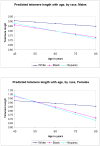Race/ethnicity and telomere length in the Multi-Ethnic Study of Atherosclerosis
- PMID: 19302371
- PMCID: PMC2713110
- DOI: 10.1111/j.1474-9726.2009.00470.x
Race/ethnicity and telomere length in the Multi-Ethnic Study of Atherosclerosis
Abstract
Telomere length has emerged as a marker of exposure to oxidative stress and aging. Race/ethnic differences in telomere length have been infrequently investigated. Leukocyte telomere length (LTL) was assessed 981 white, black and Hispanic men and women aged 45-84 years participating in the Multi-Ethnic Study of Atherosclerosis. Direct measurement and questionnaire were used to assess covariates. Linear regression was used to estimate associations of LTL with race/ethnicity and age after adjustment for sex, income, education, smoking, physical activity, diet and body mass index. On average blacks and Hispanics had shorter telomeres than whites [adjusted mean differences (standard error) in T/S ratio compared to whites: -0.041 (0.018) for blacks and -0.044 (0.018) for Hispanics]. Blacks and Hispanics showed greater differences in telomere length associated with age than whites (adjusted mean differences in T/S ratio per 1 year increase in age -0.0018, -0.0047 and -0.0055 in whites, blacks and Hispanics respectively). Differences in age associations were more pronounced and only statistically significant in women. Race/ethnic differences in LTL may reflect the cumulative burden of differential exposure to oxidative stress (and its predictors) over the lifecourse.
Figures

Similar articles
-
Sociodemographic correlates of change in leukocyte telomere length during mid- to late-life: The Multi-Ethnic Study of Atherosclerosis.Psychoneuroendocrinology. 2019 Apr;102:182-188. doi: 10.1016/j.psyneuen.2018.12.007. Epub 2018 Dec 7. Psychoneuroendocrinology. 2019. PMID: 30576944 Free PMC article.
-
Race-related health disparities and biological aging: does rate of telomere shortening differ across blacks and whites?Biol Psychol. 2014 May;99:92-9. doi: 10.1016/j.biopsycho.2014.03.007. Epub 2014 Mar 29. Biol Psychol. 2014. PMID: 24686071 Free PMC article.
-
Socioeconomic factors and leukocyte telomere length in a multi-ethnic sample: findings from the multi-ethnic study of atherosclerosis (MESA).Brain Behav Immun. 2013 Feb;28:108-14. doi: 10.1016/j.bbi.2012.10.024. Epub 2012 Nov 9. Brain Behav Immun. 2013. PMID: 23142704 Free PMC article.
-
Mediterranean diet and leukocyte telomere length in a multi-ethnic elderly population.Age (Dordr). 2015;37(2):24. doi: 10.1007/s11357-015-9758-0. Epub 2015 Mar 8. Age (Dordr). 2015. PMID: 25750063 Free PMC article.
-
Telomere length in epidemiology: a biomarker of aging, age-related disease, both, or neither?Epidemiol Rev. 2013;35(1):112-31. doi: 10.1093/epirev/mxs008. Epub 2013 Jan 9. Epidemiol Rev. 2013. PMID: 23302541 Free PMC article. Review.
Cited by
-
Paternal age at birth is associated with offspring leukocyte telomere length in the nurses' health study.Hum Reprod. 2012 Dec;27(12):3622-31. doi: 10.1093/humrep/des314. Epub 2012 Aug 30. Hum Reprod. 2012. PMID: 22940768 Free PMC article.
-
Cardiometabolic profile and leukocyte telomere length in a Black South African population.Sci Rep. 2022 Feb 28;12(1):3323. doi: 10.1038/s41598-022-07328-8. Sci Rep. 2022. PMID: 35228641 Free PMC article.
-
Race-specific associations between health-related quality of life and cellular aging among adults in the United States: evidence from the National Health and Nutrition Examination Survey.Qual Life Res. 2017 Oct;26(10):2659-2669. doi: 10.1007/s11136-017-1610-9. Epub 2017 Jun 8. Qual Life Res. 2017. PMID: 28597109 Free PMC article.
-
Childhood Personality, Betrayal Trauma, and Leukocyte Telomere Length in Adulthood: A Lifespan Perspective on Conscientiousness and Betrayal Traumas as Predictors of a Biomarker of Cellular Aging.Eur J Pers. 2016 Sep-Oct;30(5):426-437. doi: 10.1002/per.2051. Epub 2016 Oct 16. Eur J Pers. 2016. PMID: 28018048 Free PMC article.
-
Do black/white differences in telomere length depend on socioeconomic status?Biodemography Soc Biol. 2019 Oct-Dec;65(4):287-312. doi: 10.1080/19485565.2020.1765734. Biodemography Soc Biol. 2019. PMID: 33243026 Free PMC article.
References
-
- Adams J, Martin-Ruiz C, Pearce MS, White M, Parker L, von Zglinicki T. No association between socio-economic status and white blood cell telomere length. Aging Cell. 2007;6:125–128. comment. - PubMed
-
- Bakaysa SL, Mucci LA, Slagboom PE, Boomsma DI, McClearn GE, Johansson B, Pedersen NL. Telomere length predicts survival independent of genetic influences. Aging Cell. 2007;6:769–774. - PubMed
-
- Benetos A, Okuda K, Lajemi M, Kimura M, Thomas F, Skurnick J, Labat C, Bean K, Aviv A. Telomere length as an indicator of biological aging: the gender effect and relation with pulse pressure and pulse wave velocity. Hypertension. 2001;37:381–385. - PubMed
-
- Bild D, Bluemke D, Burke G, Detrano R, Diez Roux A, Folsom A, Greenland P, Jacobs D, Kronma R, Liu L, et al. The Multi-Ethnic Study of Atherosclerosis (MESA): objectives and design. Am J Epidemiol. 2002;156:871–881. - PubMed
Publication types
MeSH terms
Grants and funding
- N01-HC-95162/HC/NHLBI NIH HHS/United States
- R01 HL76831/HL/NHLBI NIH HHS/United States
- N01 HC095169/HL/NHLBI NIH HHS/United States
- N01-HC-95163/HC/NHLBI NIH HHS/United States
- N01-HC-95165/HC/NHLBI NIH HHS/United States
- N01 HC095159/HL/NHLBI NIH HHS/United States
- N01-HC-95160/HC/NHLBI NIH HHS/United States
- N01-HC-95161/HC/NHLBI NIH HHS/United States
- N01 HC095165/HL/NHLBI NIH HHS/United States
- N01-HC-95159/HC/NHLBI NIH HHS/United States
- R01 HL076831/HL/NHLBI NIH HHS/United States
- N01-HC-95169/HC/NHLBI NIH HHS/United States
- N01-HC-95164/HC/NHLBI NIH HHS/United States
LinkOut - more resources
Full Text Sources
Medical
Molecular Biology Databases

